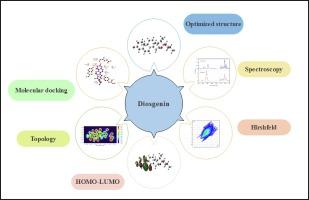Exploring the potential of diosgenin as a promising antitumor agent through comprehensive spectroscopic characterization, solvent–solute interactions, topological properties, Hirshfeld surface, and molecular docking interactions with 2NZT and 2I1V proteins
IF 4.3
2区 化学
Q1 SPECTROSCOPY
Spectrochimica Acta Part A: Molecular and Biomolecular Spectroscopy
Pub Date : 2024-10-28
DOI:10.1016/j.saa.2024.125349
引用次数: 0
Abstract
This study characterizes the steroidal saponin diosgenin by theoretical and experimental spectroscopic techniques. Theoretical simulations were performed using the DFT/B3LYP/6-311++G(d,p) basis set to simulate spectroscopic, structural and other properties. Optimized geometries from simulations and experiments showed strong agreement, with R2 value of 0.99846 for bond lengths and 0.88092 for bond angles. Vibrational spectra revealed distinctive peaks for the methyl, methylene, and methine groups in diosgenin. Solvent–solute interactions on the Frontier Molecular Orbitals (FMO), Molecular Electrostatic Potential (MEP) surfaces, and electronic spectra were analyzed, revealing insights into diosgenin’s behavior in different environments. The FMO energy gap shows that polar solvents like acetone, ethanol, and water have wider band gaps (6.22–6.23 eV) than non-polar solvents like benzene, chloroform, and toluene (6.17–6.20 eV), indicating stronger interactions with polar groups, enhanced stability, and reduced reactivity. NBO analysis shows substantial stabilization energy (14.71 kJ/mol) when electrons from oxygen’s (O1) lone pair are donated to the anti-bonding orbital of O2![]() C15 through the transition of LP (2) → σ*. The carbon (C15) situated between oxygen (O1) and (O2) exhibits increased electronegativity (−1.65605 e), confirming the electronegativity of the oxygen atoms. Hirshfeld surfaces shows that the crystal structure is mainly influenced by H…H (90.7 %) interaction. Topological analyses revealed molecular interactions and chemical bonding within diosgenin, highlighting its diverse chemical functionalities. Furthermore, molecular docking and ADME predictions underscores diosgenin’s potential biological activity against human hexokinase (−8.09 kcal/mol) and phosphofructokinase (−8.35 kcal/mol), suggesting its efficacy as an antitumor drug.
C15 through the transition of LP (2) → σ*. The carbon (C15) situated between oxygen (O1) and (O2) exhibits increased electronegativity (−1.65605 e), confirming the electronegativity of the oxygen atoms. Hirshfeld surfaces shows that the crystal structure is mainly influenced by H…H (90.7 %) interaction. Topological analyses revealed molecular interactions and chemical bonding within diosgenin, highlighting its diverse chemical functionalities. Furthermore, molecular docking and ADME predictions underscores diosgenin’s potential biological activity against human hexokinase (−8.09 kcal/mol) and phosphofructokinase (−8.35 kcal/mol), suggesting its efficacy as an antitumor drug.

通过全面的光谱表征、溶剂-溶质相互作用、拓扑特性、Hirshfeld 表面以及与 2NZT 和 2I1V 蛋白质的分子对接相互作用,探索薯蓣皂苷作为一种有前途的抗肿瘤药物的潜力。
本研究通过理论和实验光谱技术研究了甾体皂苷 diosgenin 的特性。采用 DFT/B3LYP/6-311++G(d,p) 基集进行了理论模拟,以模拟光谱、结构和其他性质。模拟和实验的优化几何图形显示出很高的一致性,键长的 R2 值为 0.99846,键角的 R2 值为 0.88092。振动光谱显示,二泽兰中的甲基、亚甲基和亚甲基基团出现了独特的峰值。分析了前沿分子轨道(FMO)、分子静电位(MEP)表面上的溶剂-溶质相互作用以及电子能谱,揭示了 diosgenin 在不同环境中的行为。FMO 能隙显示,丙酮、乙醇和水等极性溶剂的能带隙(6.22-6.23 eV)比苯、氯仿和甲苯等非极性溶剂的能带隙(6.17-6.20 eV)更宽,表明与极性基团的相互作用更强,稳定性提高,反应性降低。NBO 分析表明,当氧(O1)孤对电子通过 LP (2) → σ* 转变捐献给 O2C15 的反键轨道时,会产生大量稳定能量(14.71 kJ/mol)。位于氧(O1)和(O2)之间的碳(C15)的电负性增加(-1.65605 e),证实了氧原子的电负性。Hirshfeld 表面显示,晶体结构主要受 H...H (90.7%)相互作用的影响。拓扑分析揭示了 diosgenin 中的分子相互作用和化学键,凸显了其多样化的化学功能。此外,分子对接和 ADME 预测强调了 diosgenin 对人类己糖激酶(-8.09 kcal/mol)和磷酸果糖激酶(-8.35 kcal/mol)的潜在生物活性,表明它具有抗肿瘤药物的功效。
本文章由计算机程序翻译,如有差异,请以英文原文为准。
求助全文
约1分钟内获得全文
求助全文
来源期刊
CiteScore
8.40
自引率
11.40%
发文量
1364
审稿时长
40 days
期刊介绍:
Spectrochimica Acta, Part A: Molecular and Biomolecular Spectroscopy (SAA) is an interdisciplinary journal which spans from basic to applied aspects of optical spectroscopy in chemistry, medicine, biology, and materials science.
The journal publishes original scientific papers that feature high-quality spectroscopic data and analysis. From the broad range of optical spectroscopies, the emphasis is on electronic, vibrational or rotational spectra of molecules, rather than on spectroscopy based on magnetic moments.
Criteria for publication in SAA are novelty, uniqueness, and outstanding quality. Routine applications of spectroscopic techniques and computational methods are not appropriate.
Topics of particular interest of Spectrochimica Acta Part A include, but are not limited to:
Spectroscopy and dynamics of bioanalytical, biomedical, environmental, and atmospheric sciences,
Novel experimental techniques or instrumentation for molecular spectroscopy,
Novel theoretical and computational methods,
Novel applications in photochemistry and photobiology,
Novel interpretational approaches as well as advances in data analysis based on electronic or vibrational spectroscopy.

 求助内容:
求助内容: 应助结果提醒方式:
应助结果提醒方式:


